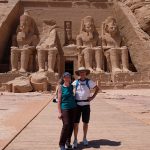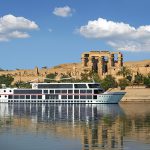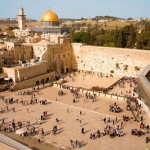Ah, the mysterious, mystical, and majestic Nile! A unique cruise opportunity for those who feel like they’ve done it all!
While disputes still exist over the exact source of the world’s longest river, everyone agrees that it begins near the equator and flows northward through eastern Africa and ends in a large delta in Upper Egypt, flowing into the Mediterranean Sea.
It’s easy to think “Egypt” when imaging the Nile, the river passes through nine other African nations on its way to the ancient land. It provides life-nourishing water for over 300 million people.
In the northern section of Africa where the Nile travels through Egypt, nearly all of the rich cultural and historical sites of Ancient Egypt are found along the river’s banks. A luxury cruise on the royal Nile delivers you directly to the doorsteps of antiquity. Here are five of our favorite reasons to explore Africa from the Nile River, “Giver of Life.”
Here are five of our favorite reasons to explore Africa from the Nile River, “Giver of Life.”
1) Giza Plateau’s Legendary Pyramids and Sphinx
Giza sits on the west bank of the Nile, approximately 13 miles southwest of central Cairo. Giza is home to the oldest and only remaining representative of the Seven Wonders of the Ancient World, the Great Pyramid of Cheops, that dates back to approximately 2690 BCE. Poke around inside one of the pyramids and wonder what daily life was like for a pharaoh 5,000 years ago.
The pyramids of Khufu, Khafre, and Menkaure, completed between 2560 BCE and 2510 BCE, await your exploration, along with the enigmatic Great Sphinx that rests on the eastern side of the plateau a short distance from the pyramids.
Back in Cairo, the Egyptian Museum of Antiquities is guaranteed to blow your mind with 107 halls filled with over 160,000 artifacts spanning 5,000 years of history, including Tutankhamun’s treasures. It’s an once-in-a-lifetime chance to get up close and personal with multiple mummies.
2) Temple of Hathor at Dendera
Protected by a massive mud brick wall, the Dendera Temple Complex is one of Egypt’s best-preserved and least-visited temples, making it ideal for intimate exploration and rumination. You’ll also find the Temple of Isis, a sacred lake, the Coptic Church, and the Ptolemaic Temple in this complex dedicated to Hathor, goddess of love, joy, and beauty. The main temple features exquisite, highly detailed astrological calendars carved and painted on the ceilings.
Intriguing hieroglyphic wall reliefs are everywhere at Dendera, once a sacred pilgrimage site where the goddess was sought for her miraculous cures. Unique to the Dendera temple are the mysterious crypts found underground and enclosed within the massive double walls of the upper temple.
3) Luxor Temple
Massive and almost overwhelming in its majesty, the temple of Luxor is a large ancient complex laid out on the east bank of the Nile River that dates back to approximately 1400 BCE. Once the sight of the most important religious festival in ancient Egypt, today the remains of colossal statues, a pink granite obelisk, colonnades, courtyards, shrines, and columns feel to stretch on forever.
The West Bank of the city of Luxor holds the Valley of the Queens and the Valley of the Kings and offers a chance to step inside the tomb of Tutankhamun. While the pharaohs of Egypt’s Old Kingdom favored burial in the Giza pyramids on the Nile Delta, New Kingdom pharaohs and their queens preferred to build their tombs in the barren hills west of Luxor. 4) Abu Simbel: Temples of Ramesses II and Nefertari
4) Abu Simbel: Temples of Ramesses II and Nefertari
Twenty years in the making, the complex at Abu Simbel boasts two of the most remarkable temples commissioned by prolific monument builder, pharaoh Ramesses II (1303-1213 BCE). The powerful construction is carved into a mountainside on the west bank of the Nile River.
Enter the Great Temple that pays homage to the pharaoh, passing by four enormous 69-feet-high statues of a seated Ramesses II at the entrance. If you happen to be visiting on October 22 or February 22, light shines into the inner sanctuary at the precise angle required to illuminate three statues seated on a bench, including one of Ramesses II.
It is believed that The Small Temple was built for Ramesses‘ favorite wife, Queen Nefertari. You’ll find two statues of the queen and four of the pharaoh along with intricate artwork and carved hieroglyphs.
5) Ride the Nile’s Wild Rapids in Uganda
Although watching the sunset over Egypt from the deck chair of your luxury cruise liner is hard to beat, for a truly extraordinary immersive experience, travel further south to Jinja, Uganda where the Nile is thought to originate.
Paddle down the river’s roaring Grade 5 rapids in a raft or kayak. End your wild adventure with a leisurely two-hour sunset river boat cruise on the Nile, cold beer in hand, as the staff serves you freshly barbecued meats, pâté , and bruschetta. How many people can say they’ve done that?



